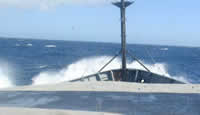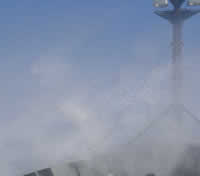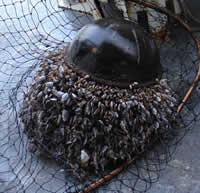


|
The Project Part 3:
Also See: Part 1: Part 2:
|
September 7, 2005
Homeward Bound We are full steam heading back to Newport. The boat bounces quite a bit more when we are traveling this fast, but the weather is very nice. The waves that splash up on the bow are pretty cool. The scientists are wrapping things up. Final counts are being made. Supplies are being packed back into boxes. Data is being crunched, and the lab is being cleaned. Mostly everyone is trying to process a lot of information. The goal is to be able to have final counts and final data to put in one data base. This way every scientist leaves with the same data. Then this project really gets started. You see, this was only the gathering information stage. They gathered information about coccolithophores in three different and distinct oceanic regions. Then they will analyze the data, which could take around a year. Then they will be writing papers comparing and contrasting the coccolithophores in the different areas. They want to know what about them is the same, what about them is different, and why. This information, after it is published, becomes part of the information base that other scientists can draw from when they are trying to figure other things out. We pick up random sea garbage, whenever we find it. Last evening we picked up a black plastic float that was so covered with barnacles that it looked like a biker's helmet over a huge beard. The barnacles get scraped off back into the sea, and the plastic is stowed to be disposed of back at dock. Our ships are very careful not to allow any plastic overboard, as it is harmful to the creatures in the sea. We have to stop about 30 to 40 miles outside of Newport to pick up an anchor. Another science vessel had some equipment in the water. They were able to retrieve all the equipment, but they weren't big enough to pull the anchor out of the water. So we are going to stop at the correct coordinates and look for the buoy that marks this thing. Hopefully I'll have some pictures tomorrow. Here's the answer to yesterday's shape question. The shapes that were hanging from the ship yesterday were a black ball over black diamond over black ball, which means vessel restricted in ability to maneuver. We put this up to let other ships know that we have something in the water that makes it hard for us to move. Math Questions: Here's the answer to yesterday's question. The two consumable products you never want to run out of are coffee and toilet paper. Everything else you can deal with, but if these two things are gone there will be a lot of complaining. Here is another food question, but this time it is wildlife related. A blue whale calf drinks 130 gallons of milk a day from its mother. You much milk will it drink in two days? a week? This baby weighed two tons at birth. If it gains ten pounds an hour, how long will it be before it weighs three tons? (1 ton = 2,000 pounds) Ocean Trivia: There are some superstitions that just defy explanation. For example, the loss of a bucket or mop overboard was considered a bad omen, as were black traveling bags. Hearing bells at sea was a sure sign of an upcoming death, but the feather of a wren was supposed to protect against death by shipwreck. There is still treasure at sea. For example, the steamship Central America sank off the east coast of America on its way to New York in 1857. On board were 592 passengers and 2 million dollars (in that day's money) worth of gold from the California Gold Rush. It's hard to say how much that would be worth today. People with modern technology have tried to find it, but no luck so far.
|



